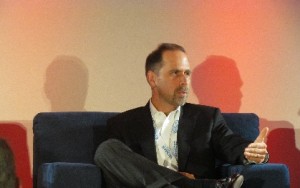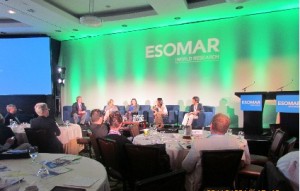After a wonderful evening dinner cruise around Miami (seems the weather Gods are on our side), we started the morning with one of the most anticipated speakers of the event – Sean Bruich, from the Measurement Research department of Facebook.
Noting that the seminal challenge for MR today is how we can make feedback fun and interesting, Sean took us on a journey through surveys starting with an overview of the earliest of surveys in the 1930’s …and it’s a bit surprising to see that surveys have not really changed much despite the years ….which seems to be part of the problem. 
What researchers want is for people to stop and take our surveys, but what it really being communicated is “stop what you are doing and leave a trusted environment, give away trusted information, spend precious time and get nothing in return.”
So Facebook is asking – What can we do to make participation in research have a reward? I think this conference shows that they are not the only ones…
Facebook wants to make participation research seamless into the FB experience i.e. never leave the site and inject it into the ad site of the page. They found that people seem to not mind as they are already going about sharing things in their lives in other ways on the page, so it doesn’t seem too strange to answers more questions.
But how does the data compare in a facebook survey, i.e. how do they respond and how well do they perform with their surveys? Is the data of high quality? Well, once a week Facebook asks the same questions as Gallup and Rasmussen and have found there to be incredible alignment with the more scientific polling – a bit eerie in fact. So, it goes without saying that they have confidence in the data. This has also worked in predicting box office success in movies which once again showed a high correlation (over 0.9).
Text Analysis
People are talking a lot more in measurable ways. So how does FB approach text analysis? As we have learned from various studies, people think more than they talk. The chatter itself is quite a small piece of the puzzle, because there are other missing pieces – i.e. what is the influence of that chatter? When someone has a good experience with a product or service – what do their friends think of that?
Facebook believes that NLP and sentiment analysis is good – but notes that a lot of data suggests that reactions from friends is very powerful. People are 60%more likely to remember exposure if their friends liked it. They announced that they plan to explore more what is the nature of social influence and friendships amongst topics.
Although advertisers want to target the influencers and they will push out my message i.e. “the Oprah Effect”, Facebook found that everyone has a platform and everyone is an influencer. So how do things become popular on Facebook? It’s not from that smaller influencer set that everyone focuses on….In the world of Facebook, its about people “liking” a product and that “like” spreads to people they are connected to through the newsfeed. Apparently, demographics, numbers of friends and those things do not predict success…. It is all about exposure. Each person holds the key and is the influence. This must make Facebook happy but should also scare the hell out of them.
 Following Sean, we heard from Dr. Carl Marci, of Innerscope and Keith Berkelhemer of CNN who discussed just what happens when you bring news (articles, videos, etc..) into the social media conversation.
Following Sean, we heard from Dr. Carl Marci, of Innerscope and Keith Berkelhemer of CNN who discussed just what happens when you bring news (articles, videos, etc..) into the social media conversation.
According to proprietary Nielsen data provided to CNN, Facebook alone created over 92 billion impressions in the third quarter of 2010. Forrester Research predicts it will be the “hottest” area of online advertising for several years to come.
Using the analogy of music festivals drawing crowds, Berkelhemer noted that social networks are essentially aggregators. As it stands, news has grown from a transfer of information to a type of social currency. And the numbers show that CNN has 14 million page views monthly, 1.4 million monthly shares and 850K monthly comments.
CNN uses biometrics to filter through the chatter and better gauge what people will do. As Marci pointed out – people often say one thing and feel another and feel one thing and do something else.
They presented a study design using biometrics including eye tracking, measuring skin sweat, heart rate, breathing and motion. They aggregated these channels to measure emotional engagement – i.e. attention to something that emotionally impacts a person. Emotions tag information for relevance.. .something that is good for us to remember…
This study in Boston recruited friendship pairs between the ages of 2-54 and regular users of CNN.com and Facebook. They used a combination of visual attention when looking at the ads and biometric response. Those in the receptive state of mind were 3.7 times more engaged when they received an article recommendation from a friend. Influencers were 2x more engaged with news content they shared.
From this data CNN has been able to institute actionable insights including offer advertising which bundles this research into packages to give clients the capability to reach a more interested crowd.
Communispace’s Manila Austin and Katrina Lerman explored how to better engage BRIC consumers in MROCs.
Using password protected communities they found clear pockets of engagement from country to country. The focus in the presentation was on a specific community profile – youth and millennials. They found that this group is highly diverse (which is a draw) and that they help shape global brands because they love to share experiences, challenges and milestones. Main takeaway – keep the tone fun, content frequent and methods flexible for a successful MROCs in this group.
BRIC country members were more likely to read than post and specifically members in China and India participated more frequently when they could address many brands at once and they had new posts at least twice a week giving them new information to work with…
Lessons – despite size difference in the communities there were universal themes.
- Leverage the Diversity – recognising that diversity is a draw and not a barrier in a community.
- Know why you are there – know who to target and why you are doing it. Sounds obvious, but that clearly isn’t always the case. Make sure you are using the right tools for the right research and speak to a commonality – life stage, brand passion, etc… while providing acknowledgement and feedback.
- Beware the western lens – a facilitation team should reflect diversity whenever possible. Clear language, avoid idiom or slang, use simple language and treat all with respect.
- Authenticity is key – the more you can do to know the culture and are aware of their needs the more this will relax members. Provide a lot of ways to for them to express themselves – i.e. multimedia tools which can allow for unfiltered emotion for those with language challenges
- Allow consumers to show and not just tell – multimedia!
- Facilitators must play an active, not passive role and this needs commitment. It is a daily job that requires time, research, patience, attention to detail and requires much more presence than normal, especially if there are language issues.
 There are no bad countries in regards to engagement – it just depends on right value proposition.
There are no bad countries in regards to engagement – it just depends on right value proposition.
Philips’ Isabella Hoi Kee , illustrated how to use co-creation to break away from one-way mirror phenomenon of focus groups – from anonymous respondents to an open and public community. They did not use recruiters but went through Facebook and Twitter to find people passionate about food or personal rituals. Using face-to-face, diaries and other methods, Philips found that the benefit lies in mixing the methods and then strategised about how to use these in the online space.
They reviewed two projects to understand current cooking behaviours in Spain and Germany and rituals and one in understand personal rituals Brazil, China, USA and Germany.
In these studies they found they have to move from more passive to active to inspire internally – R&D, marketeers and more. The move from users to community participants – engaging them in an on-going basis and combining internal and external stakeholders was fundamental.
The also evolved from observation to provocation – friends interviewing friends and provided a calendar magnet to have constant presence. They asked children to not use one personal care product for 3 days (teenage boys)and it was interesting to see how hard it was for them and how much they identify with their products like facial cleaner and after shave. These passions drove the communities and inspired multimedia and conversation in the community itself.
Learnigns: They moved from analysis to co-creative synthesis by moving from segmentation to personsas, from reports to experience flows (avoid the folder in desk syndrome) and moved from written insight to experience scenarios. Drive for more inspiring insights and once again keep your focus on the three “F”s – fun, frequent and flexible.
Japan post Tsunami
3-11 is a date that the Japanese will never forget – the date when a 9.92 earthquake struck Japan, triggering a tsunami and subsequently causing nuclear power plant issues and mass electrical power shortages. 
So how did all of this change the lifestyles and purchase behaviours of consumers in Japan? As Koki explained these things tend not to change on a large scale very frequently, but big disasters in such a short period often do…
Their challenge was to determine whether to use social media monitoring or social media research and what would be the best key words to get answers under these circumstances.
They put together a diverse group from various industries – food and beverage, automotive, housing, etc…to get their perspectives and adapted a brainstorming method. From this they found more than 600 areas which could be affected from these disasters such as life health relationships, jobs, etc…and this provided them with the missing keywords.
They then extracted data from social media using these key terms to target 23 million bloggers (instituting a spam filter – makes Annie Pettit happy I am sure!). They chose blogs and not twitter or Facebook because blogs include background information and reasoning and as a form of communication, they have a solid past in Japan. They explored seasonal effects (3 years of data collection) – for topics including beer and found that after the earthquake the demand for beer went up hugely.
They also discovered that saving energy was more important than nuclear power plants – because the reach was broader nationally versus regionally where plants were located. The study showed that fear rose hugely after earthquake, but one month later it was back to normal levels. For the Japanese fear evolved into hang in there and cheer up which then led to healing .
The Japanese people’s sense of values changed from rich to simple and modest, with more focus on Japanese tradition, flexibility as well as solidarity/community spirit and social contribution. People became less materially focused on more focused on green initiatives, support and community.…
This was a wonderful presentation on how Market research can really have a positive social impact in understand people. The heartfelt thank you that followed to the industry and to the global community was certainly one of the most moving experiences I’ve had at an event and from the tweets I’ve read – I’m not the only one.
 Over the years the idea of non-traditional marriages has sparked immense controversy. Using the metaphor of marriage, Decipher’s Kristin Luck did her best to convert the crowd into supporting her belief in what many may consider research miscegenation….i.e. the marriage between online strategies and integrated mobile/social media outreach.
Over the years the idea of non-traditional marriages has sparked immense controversy. Using the metaphor of marriage, Decipher’s Kristin Luck did her best to convert the crowd into supporting her belief in what many may consider research miscegenation….i.e. the marriage between online strategies and integrated mobile/social media outreach.
Metaphor aside, Luck’s presentation highlighted the challenges we researchers face as we move further into a world where mobiles and tablets dominate consumer time and in many ways dictate our ability to interact with them on a timely and truly insightful basis. 43% of Facebook users access it through their mobiles…
What does this mean for us as researchers –
Respondent cooperation and access and platform preferences are huge issues for us. It doesn’t matter what we want, but what they want.
Tracking WOM and passive data collection and targeted river sampling are also issues to be examined in this sphere. App-based surveys are of interests to many and we should be questions how many apps are respondents really willing to download. There is also a debate over blending between mobile and non-mobile and if that is a good thing. Decipher aims for a more qualiquant mix.
Mobiles offer amazing opportunities – check out the content rich resume from her presentation
Privacy – really depends on the users group and age group seems to have a big impact. But we must keep this in mind more and more as this develops as people may not be aware of how this is affected with a mobile.
Noting that Mobile access had created a “nomadic” expectation of access to everything and anything, Luck underscored the idea that “respondents expect to be met on their own turf – through their mobile phone or device”.
Key takeways: Keep surveys shorter and you will see better success and getting respondents to answer mobile surveys. Minimise all non – essential content (logos, progress bars, etc… Keep the look simple and most importantly, make enjoyable (maybe gamification). Stay focused on the user experience – and stay aware of the industry!
In this presentation, Luck assured us that mobile marketing (SMS, MMS, and more) are here to stay.
 Following Kristin was Adhil Patel, who did a very entertaining interactive prezi presentation on mobiles and how they hold the key to tactical and actionable research. Using mobile phone looking voting cards, he took the audience through a gamified presentation – with a few surprises along the way.
Following Kristin was Adhil Patel, who did a very entertaining interactive prezi presentation on mobiles and how they hold the key to tactical and actionable research. Using mobile phone looking voting cards, he took the audience through a gamified presentation – with a few surprises along the way.
How soon do you think mobile will overtake traditinal online? Adhil Patel’s 3D presentation’s experts said 2-4 years, while the delegates said 5 or more. Let’s see who was right? With Kristin Luck as his Vanna White (google Wheel of Fortune for those who don’t know), Adhil showed that gamifying a process can indeed engage an audience – even one that is full of researchers who do not always believe in the concept.
The Royal Wedding
Like the Japanese Tsunami presentation from earlier, Simon Atkinson of Ipsos and Sean Conry of Techneos used the British Royal wedding to gauge a particular moment in a country that changed/affected lives. Although it was a much different sort of experience from Japan, it was one that became a part of life of Britons and the world at large – even if only for entertainment value.
Using traditional opinion polls, surveys and mobile ethnography to understand how this rare experience was for British people, Atkinson and Conry measured the intensity of sentiment by filtering through noise online (twitter, youtube, The Telegraph etc..) – and found that mentions of street parties rose dramatically closer to the dates, even though main stream press stated statistics showing a fair share of Britons didn’t really care much. Funny, how this conference is really hammering in the idea that what people say and what they do can be dramatically different. If I wasn’t a believer before, I am now!
They also found a Halo effect – i.e. that British men ended up enjoying the event despite pre-event data where they didn’t think they would. They also discovered that pre-wedding many Brits believed the monarchy would not have a future contrasting post-wedding results which showed they believed the Royals just might stand a chance.
As they said this multi-use approach provides rich insights and allows for applications in a variety of different situations such as teh upcoming Olympic Games in London, customer experience (i.e trigger points and behavioural changes) and communications research and how is this information digested in real time.
Nathan Eagle and Researching the Next billion
Nathan Eagle, of Jana (formerly txteagle) managed a somewhat impossible feat – to engage the interest of the delegates in the last session of 3D (not always the most enviable slot in the roster).
 Driven to build apps that make an impact, Eagle went to the University of Nairobi where he developed a mobile app curriculum that is still circulating throughout Africa. The unique thing about these apps is that they are designed for that particular market and built by African coders- something extremely important to fit within the specific needs of the area.
Driven to build apps that make an impact, Eagle went to the University of Nairobi where he developed a mobile app curriculum that is still circulating throughout Africa. The unique thing about these apps is that they are designed for that particular market and built by African coders- something extremely important to fit within the specific needs of the area.
By building relationships with operators, Eagle found it made life easier for making apps that matter – such as the app his company made for making better blood banks in East Africa. It allowed rural nurses to text to orderblood supplies to better time shipments from centralised blood banks. Although it was good idea, the nurses stopped using it because the price was too prohibitive, and after a month the project risked failure. This was a wake up call for Eagle – that economic disadvantage can indeed affect even the best innovations. However, by using mobile phone credit to incentivise behaviour, he got them back on board, which is a interesting concept that could be a good idea for outside Africa as well.
So why should anyone really be interested in emerging areas, asked Eagle. Because when asking global brands where they anticipate future earnings/revenue to come from – they always say from BRIC, because they are aware of the potential. We will see globally a growth of 300 trillion by 2050 and it won’t be from the traditional places – US, Western Europe, etc… Stock tip – Nigeria is the place to watch…
“It’s a mistake to see mobile as a panacea”, he warned. But mobile is really the only way to penetrate globally – not mobiles with apps, but mobile as you thought of 10 years ago. What about the internet? Many of those in developing countries will access it via mobile – so this is indeed the future.
Pay attention to post-paid versus pre-paid. The vast majority of mobile subscribers globally are pre-paid, but use their phones for many things including payments for food, taxi’s etc… since this is the only device many have access to ( no credit cards, bank cards, bank machines). His company is sending surveys through the same protocol system people use to load up credit on their phone. All free of charge….
If this is where amazing technology is happening, then maybe we need to reframe the idea of who is indeed a developing market or developed in this sense (I can’t even pay in a taxi cab with my smartphone). Mobile is a great source of people and provides a great cross-population incentive for as well. He showed that it is good for basic data collection (limited in questions and clear style) and will likely continue to serve as a driver for people to better interfaces. A wonderful and insightful presentation.
With the close of Eagle’s presentation we found ourselves at the end of the event, and the close of what was truly an engaging and thought provoking two days. If you don’t beleive me, sort through the blogs and tweets…
I also want to mention two award winners from this event. Best Paper was one by Dr. Carl Marci and Keith Berkelhemer with Leveraging the Power of Social Media – The Impact of Shared news content on consumers and Best Presentation was won by Peter Harrison of BrainJuicer – in his first ever conference presentation! Congratulations to you all and we look forward to seeing more of your work on our stage.
A sincere thank you to everyone who attended and supported this conference. The Programme Committee and speakers worked hard to give you what was a very, very good show and delegate particiaption made it even more rich. Let’s keep this up. Brainstorm for new ideas and let’s see what we can bring next year. I’m certainly looking forward to it!


